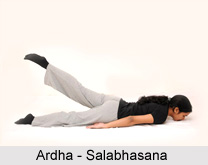 Ardha - Salabhasana is a cultural asana and an adaptation of another posture called Salabhasan. It is also known as the half locust pose. This posture is not taken from any of the original Yogic texts, but was devised by contemporary yogis as an adaptation of the Salabhasana. Ardha-Salabhasana gives the same advantage as Salabhasana; it benefits the pelvis and the abdomen.
Ardha - Salabhasana is a cultural asana and an adaptation of another posture called Salabhasan. It is also known as the half locust pose. This posture is not taken from any of the original Yogic texts, but was devised by contemporary yogis as an adaptation of the Salabhasana. Ardha-Salabhasana gives the same advantage as Salabhasana; it benefits the pelvis and the abdomen.
Practice of Ardha - Salabhasana
The steps for practicing this asana are as follows-
•The person first has to come to the pose of Salabhasana; this posture will make him lie flat on his seat.
•All his muscles are to be kept in a relaxed condition and throughout the exercise breath has to be allowed to have its normal flow.
•The practice starts by raising backward one of the legs, after contracting the necessary set of muscles.
•The practitioner has to raise his one leg so slowly and steadily that little pressure is experienced except on the parts that are actually working.
•The trunk and the other leg are to be kept close to the seat during this action.
•When the leg that is being lifted backward has described the greatest possible angle, it is slowly to be lowered down to its original position.
•Then the other leg is to be raised and taken through the same movements. Thus, the two legs go on working alternately till the preferred amount of exercise is completed.
Benefits of Ardha - Salabhasana
•It strengthens and tones the pelvis and abdomen.
•It toughens the arms, shoulders and muscles of the back.
•It stimulates appetite and improves the digestive process.
•It balances the autonomic nervous system.
•It enhances the functioning of the liver and other abdominal organs.
•It eases stomach disorders.
Caution about Ardha - Salabhasana
Control of breath and stiffening of muscles may be introduced as the practice for the advanced Yogis. Care should be taken to see that no strain is put upon the system on that account. After one feels strong enough to tackle the complete Locust pose, that should be substituted for the Half Locust Pose as well.




















